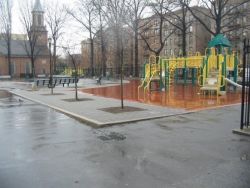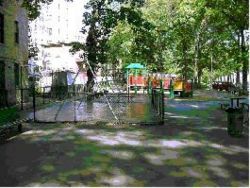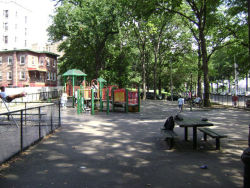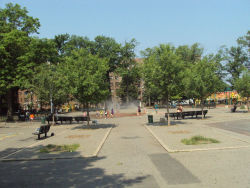Washington's Walk
Old Fort Four Park
What was here before?
This site was once part of the Jerome Park Racetrack between 1876 and 1890. The track was closed to make room for the Jerome Park Reservoir, which was first filled in 1905, holding 773 million gallons of water. The racetrack and reservoir take their name from Leonard W. Jerome (1817-1891). He helped found three racetracks and the American Jockey Club, was a patron of the arts, and established the Academy of Music. His daughter, Jennie Jerome, was the wife of Randolph Churchill and the mother of Winston Churchill.
How did this site become a park?
This property was acquired by condemnation in 1895 as part of the Jerome Park Reservoir and was placed under the jurisdiction of the Department of Parks in two parcels in 1913 and 1931. The playground was opened to the public in 1934. The facility included a basketball court, paddle tennis, see-saw, swings, and a shower basin. The park benefited from an extensive rehabilitation in 1988, including play equipment, benches, drinking fountains, and step repair.
In 1998, Old Fort Four Park was renovated with new safety surfacing and asphalt, remodeled playground equipment, and a new community garden. A major feature of the facility is a piece of playground equipment with a music wall and a variety of overhead ladders, loops, bridges, and slides.
What is this park named for?
This park was named after the fort that stood nearby here in colonial times.
The Bronx neighborhood of Kingsbridge, so named for the first bridge connecting Manhattan with the mainland in 1693, was strategically important during the American Revolution in the New York Campaign and subsequently in the British defense of the city. As Commander-in-Chief of the Continental Army, General George Washington ordered the construction of outer defenses throughout the Kingsbridge area. Fort Four was built under the direction of Colonel Rufus Putnam in 1777 to protect the American army and to safeguard the line of the Harlem River. The largest of all fortifications in the neighborhood, Fort Four was strategically situated, commanding a view for miles in all directions. In the fall of 1779, the fort was destroyed by the British forces led by Sir Henry Clinton. The site is marked by a flagstaff and a bronze tablet erected by the Daughters of the Revolution in 1914
Check out your park's Vital Signs
Clean & Safe
Green & Resilient
Empowered & Engaged Users
Share your feedback or learn more about how this park is part of a
Vital Park System









